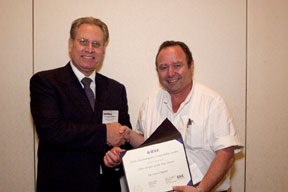 |
| Moshe Netzer accepted the “Chapter
of the Year” award from Kimball Williams on behalf of
the Israel Chapter. |
Fall!
At this time of year in Michigan, we can look up at almost any
time of the day and see flocks of geese, ducks, and other migratory
birds forming into squadrons in attack ‘V’ formation
preparing for a long flight south for the winter. Michigan, due
to the straights at Mackinaw, is a major flyway for feathered
creatures of all types. They use the route straight up though
the state’s lower peninsula up to the joining of Lake Michigan
and Lake Huron where there is only a short stretch of water to
cross, instead of several hundred miles of water, for instance,
if they flew up the center of Lake Michigan, parallel to the land.
The land route is ‘safer’ since it is possible to land
in many lakes and rivers that cover the inland areas of Michigan.
However, the lakes and rivers are also where hunters set up their
‘blinds’ and set out their ‘decoys’ in an
attempt to coax some of the high flying travelers down into rifle
range. No route is completely safe. There is always a trade-off
with positives and negative implications for any decision. Sounds
like engineering, doesn’t it?
Snowbirds
There is another migratory creature that makes its summer home
in northern states like Michigan. We call them ‘snowbirds’,
but they are usually retired couples that pack up their lives
each fall and spend the winter in warmer states like Arizona and
New Mexico. This used to be the refuge for people who suffered
from respiratory diseases. Desert states with only minimal flora
to spread pollen on the wind were the safe harbors for those with
allergic reactions to such as ragweed pollen.
However, the advent of relatively inexpensive electricity and
the invention of air conditioning systems have made living in
desert climates year round something that even a Michigander such
as myself can find manageable. And many do! So many, in fact,
that the natural tendency to bring a bit of home with you when
you travel, has brought large areas of green to what once were
deserts in the form of lawns, gardens and farms, all watered from
deep wells that modern methods have allowed us to tap. Now, the
previously pollen free air of some Southwestern cities has so
much pollen, that doctors are looking for more remote areas to
send their severely asthmatic patients. (Mars?)
This summer, Phoenix, Arizona reported a record number of West
Nile infections, far exceeding any seen elsewhere in the country.
The West Nile infection is spread by a mosquito bite. Mosquitoes
need water in which to breed. Standing water is preferred. One
official in Phoenix used an analogy to describe what was happening
in his state. He referred to Minnesota as the “land of a
1,000 lakes”, but Arizona is the land of 10,000 abandoned
swimming pools! Our ‘snow birds’ bring their lifestyle
with them, and it has had an unexpected consequence.
Consequences
If all of this sounds hauntingly familiar, like the type of problem
we see in our work as EMC engineers every day, should be no surprise.
As human beings, everything we do has effects that extend beyond
our prime intention. As EMC engineers, that is our bread and butter.
Unintended consequences are just what EMC is composed of in the
first place.
However, we are not immune to this same phenomenon. What we do
can also have unintended consequences, some we have learned to
anticipate. The EMC ‘fix’ that is so expensive that
we have just soaked up all of the potential profit in the product
we just ‘fixed’ is one we run into all the time. “Back
to the drawing board” is the usual response to discovering
we have just found the perfect cure to an EMC problem that sinks
the product.
Alternatives
One very good engineer in the aerospace industry once told me
that, “If you haven’t found at least three solutions
to the problem, you should look a bit harder.” So far, I
have found this advice to be valid. Usually, one of those three
solutions has different ‘unintended consequences’ from
the others, and this leads to other solution options, etc. This
is definitely one of those cases where Thomas Edison’s, “It’s
not inspiration, it’s perspiration!” holds true. Persistence,
as the tortoise found out, wins in the end.
Is this what distinguishes the ‘genius’ from the regular
guy? The geniuses just never give up? If this is so, then there
is a powerful lesson to be learned here. (At least by me!) As
long as there is a will, there will eventually be a way that can
be found or created.
But, persistence is hard! Especially when someone is demanding
instant answers, because persistence, by its very nature, takes
time. We all want ‘the answer’ as soon as we can come
up with it. That is another lesson: “It is not the destination,
but the journey that is important.” The ink paintings of
the Chinese and Japanese sages were one way to put that lesson
in front of their students. Roll the scroll and see that landscape
pass before you. Each part captured in loving detail, with patience
and calm. If there is a journey’s end depicted in any of
those scrolls, I don’t recall ever noticing. One is captured
by the journey, and begins to understand that joy in each step
is what makes the trip worth the effort. Some may reach the ‘goal’
before we will, but their ‘goal’ will not be the same
as ours. Ours we reach with every step along the way.
Now, go try to bring your business manager up to that level of
inner awareness! EMC